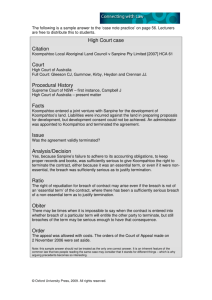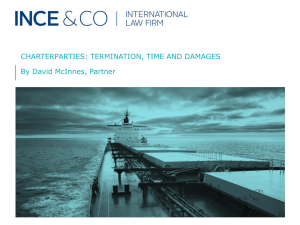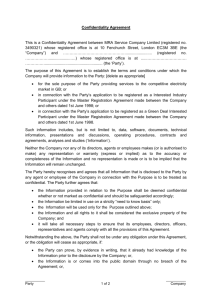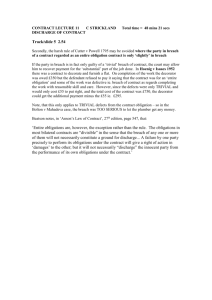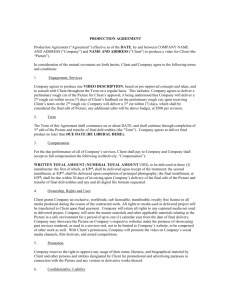When Is An Innocent Party Entitled To Terminate A Contract?
advertisement
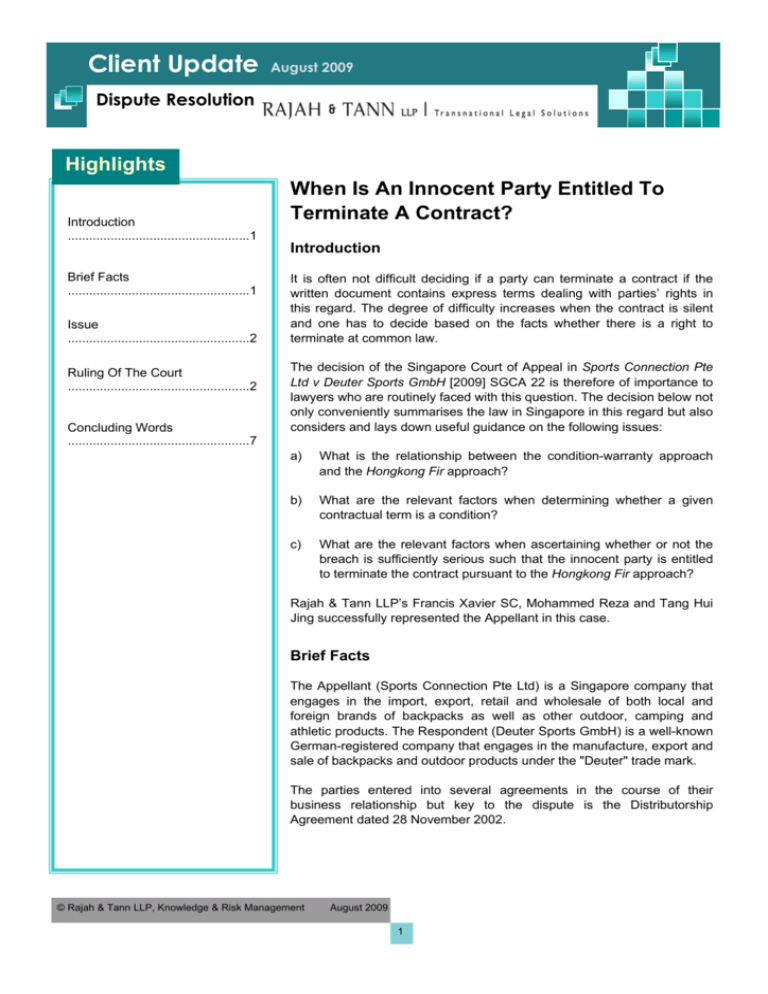
Client Update August 2009 Dispute Resolution Highlights Introduction ...................................................1 When Is An Innocent Party Entitled To Terminate A Contract? Introduction Brief Facts ...................................................1 Issue ...................................................2 Ruling Of The Court ...................................................2 Concluding Words ...................................................7 It is often not difficult deciding if a party can terminate a contract if the written document contains express terms dealing with parties’ rights in this regard. The degree of difficulty increases when the contract is silent and one has to decide based on the facts whether there is a right to terminate at common law. The decision of the Singapore Court of Appeal in Sports Connection Pte Ltd v Deuter Sports GmbH [2009] SGCA 22 is therefore of importance to lawyers who are routinely faced with this question. The decision below not only conveniently summarises the law in Singapore in this regard but also considers and lays down useful guidance on the following issues: a) What is the relationship between the condition-warranty approach and the Hongkong Fir approach? b) What are the relevant factors when determining whether a given contractual term is a condition? c) What are the relevant factors when ascertaining whether or not the breach is sufficiently serious such that the innocent party is entitled to terminate the contract pursuant to the Hongkong Fir approach? Rajah & Tann LLP’s Francis Xavier SC, Mohammed Reza and Tang Hui Jing successfully represented the Appellant in this case. Brief Facts The Appellant (Sports Connection Pte Ltd) is a Singapore company that engages in the import, export, retail and wholesale of both local and foreign brands of backpacks as well as other outdoor, camping and athletic products. The Respondent (Deuter Sports GmbH) is a well-known German-registered company that engages in the manufacture, export and sale of backpacks and outdoor products under the "Deuter" trade mark. The parties entered into several agreements in the course of their business relationship but key to the dispute is the Distributorship Agreement dated 28 November 2002. © Rajah & Tann LLP, Knowledge & Risk Management August 2009 1 Client Update August 2009 Dispute Resolution Contacts Francis Xavier SC Partner Direct: (65) 6232 0551 Facsimile: E-mail: (65) 6533 0827 francis.xavier @rajahtann.com Mohammed Reza Partner Direct: (65) 6232 1197 Facsimile: E-mail: (65) 6533 0827 mohammed.reza @rajahtann.com The Distributorship Agreement contained a non-competition clause which stated that “[p]roducts which are in competition with Deuter range of products may not be sold by [the Appellant] without prior written consent from [the Respondent]" ("the Non-Competition Clause"). The Trial Judge accepted that there was an "understanding" between the parties that the Non-Competition Clause in the Distributorship Agreement would not be activated if the Appellant purchased US$1 million worth of Deuter products annually ("the Purchase Target"). This understanding is not in dispute between the parties for the purposes of the present appeal. On 27 January 2005, the Respondent issued a notice of termination and terminated the Distributorship Agreement on four grounds. One of the grounds relied upon was that the Appellant had, in breach of the non-competition clause, sold competing products without obtaining the Respondent’s written consent. At the appeal, this was the sole ground relied upon by the Respondent as forming the basis for terminating the Distributorship Agreement. Issue The only issue before the Court of Appeal was whether or not the Appellant’s continued sale of competing products in contravention of the Non-Competition Clause constituted a breach which entitled the Respondent to terminate the Distributorship Agreement. As the Distributorship Agreement did not contain any early termination provision, the above issue turned on whether the Respondent was entitled to terminate the Agreement under common law. Ruling Of The Court The Court of Appeal affirmed the principles laid down in the decision of RDC Concrete Pte Ltd v Sato Kogyo (S) Pte Ltd [2007] 4 SLR 413 as to when the innocent party can terminate a contract. Please feel free also to contact the Knowledge & Risk Management Group at eOASIS@rajahtann.com. © Rajah & Tann LLP, Knowledge & Risk Management August 2009 2 Client Update August 2009 Dispute Resolution A brief summary of such principles was set out in a subsequent Court of Appeal decision of Man Financial (S) Pte Ltd v Wong Bark Chuan David (“Man Financial”) [2008] 1 SLR 663 as follows: "153 As stated in RDC Concrete, there are four situations which entitle the innocent party ... to elect to treat the contract as discharged as a result of the other party's ... breach. 154 The first ("Situation 1") is where the contractual term in question clearly and unambiguously states that, should an event or certain events occur, the innocent party would be entitled to terminate the contract (see RDC Concrete at [91]). 155 The second ("Situation 2") is where the party in breach of contract ("the guilty party"), by its words or conduct, simply renounces the contract inasmuch as it clearly conveys to the innocent party that it will not perform its contractual obligations at all (see RDC Concrete at [93]). 156 The third ("Situation 3(a)") is where the term breached ... is a condition of the contract. Under what has been termed the "condition-warranty approach", the innocent party is entitled to terminate the contract if the term which is breached is a condition (as opposed to a warranty): see RDC Concrete at [97]. The focus here unlike that in the next situation discussed below, is not so much on the (actual) consequences of the breach, but, rather, on the nature of the term breached. 157 The fourth ("Situation 3(b)") is where the breach of a term deprives the innocent party of substantially the whole benefit which it was intended to obtain from the contract (see RDC Concrete at [99]). (This approach is also commonly termed the "Hongkong Fir approach" after the leading English Court of Appeal decision of Hongkong Fir Shipping Co Ltd v Kawasaki Kisen Kaisha Ltd [1962] 2 QB 26; see especially id at 70.) The focus here, unlike that in Situation 3(a), is not so much on the nature of the term breached, but, rather, on the nature and consequences of the breach. 158 © Rajah & Tann LLP, Knowledge & Risk Management Because of the different perspectives adopted in Situation 3(a) and Situation 3(b), respectively (as August 2009 3 Client Update August 2009 Dispute Resolution briefly noted above), which differences might, depending on the precise factual matrix, yield different results when applied to the fact situation this court in RDC Concrete concluded that, as between both the aforementioned situations, the approach in Situation 3(a) should be applied first, as follows (id at [112]): If the term is a condition, then the innocent party would be entitled to terminate the contract. However, if the term is a warranty (instead of a condition), then the court should nevertheless proceed to apply the approach in Situation 3(b) (viz, the Hongkong Fir approach).” [emphasis added] Relationship Between Condition-Warranty Approach And The Hongkong Fir Approach Academics have criticised the decision in RDC Concrete in its failure to exclude the Hongkong Fir approach where the parties have in fact agreed that the term breached is a "warranty". They argued that if parties had intended a term to be a warranty, then it would mean that they did not intend a breach of that term to give rise to a right to terminate. To insist on applying the Hongkong Fir test even where the term breached is clearly a warranty would seem to go against the parties’ intention. The Court stated that if the condition-warranty approach is – as is suggested by these academics - treated as admitting of only one of two possibilities, ie, that a term is either a condition or a warranty, then there is logically no place for the Hongkong Fir approach which is premised on there being terms which though not conditions but would nonetheless yield serious consequences if they were breached – i.e. the intermediate or innominate term. But the Court thought that such an approach is undesirable. As the Hongkong Fir decision has been adopted in all major Commonwealth jurisdictions, it is a decision which the Court of Appeal felt it should continue to endorse. However, just because the Hongkong Fir approach is to be adopted, one does not need to go to the other extreme of completely effacing (in substance at least) the condition-warranty approach. Hence, the Court was of the view that the approach adopted in RDC Concrete (combining the condition-warranty approach with the Hongkong Fir approach) is the only one which permits the Hongkong Fir approach to be accommodated in any meaningful sense. © Rajah & Tann LLP, Knowledge & Risk Management August 2009 4 Client Update August 2009 Dispute Resolution In the Court’s view, "legal space" must be made for the application of the Hongkong Fir approach, which itself embodies its own conception of fairness. The fairness in this regard would lie in avoiding the potentially grave injustice which could be occasioned to the innocent party who could potentially suffer the serious consequences of the breach but is unable to terminate the contract because the term is given the legal status of a "warranty" (pursuant to the condition-warranty approach). The Court therefore reaffirmed the approach laid down in RDC Concrete for the reasons set out above, subject to the extremely limited exception that, where the term itself states expressly (as well as clearly and unambiguously) that any breach of it, regardless of the seriousness of the consequences that follow from that breach, will never entitle the innocent party to terminate the contract, then the court will give effect to this particular type of term (viz, a warranty expressly intended by the parties). Relevant Factors When Determining Whether A Contractual Term Is A Condition In dealing with this question, the Court quoted extensively from the Man Financial decision. In brief, the principles are summarised below: a) Many factors would come into play in making this determination but the overall focus is on ascertaining the intention of the contracting parties themselves by construing the actual contract itself (including the contractual term concerned) in the light of the surrounding circumstances as a whole (see the classic exposition on this point by Bowen LJ (as he then was) in the oft-cited English Court of Appeal decision of Bentson v Taylor, Sons & Co (No 2) [1893] 2 QB 274 at 281). b) The first of the established factors is very specific. Where a statute (or, more often, a particular provision within a statute) classifies a specific contractual term as a "condition", then that term will be a condition. c) The second factor: Where the contractual term itself expressly states that it is a "condition", then that term would generally be held by the Court to be a condition. However, there is case law that suggests that the express use on the word "condition" might (on occasion, at least) be insufficient to render that term a condition in law. In this regard, see the House of Lords decision of L Schuler AG v Wickman Machine Tool Sales Ltd [1974] AC 235. d) © Rajah & Tann LLP, Knowledge & Risk Management The third factor is whether a prior precedent is available. An oft-cited illustration in this regard is the English Court of Appeal decision of Maredelanta Compania Naviera SA v Bergbau-Handel GmbH [1971] August 2009 5 Client Update August 2009 Dispute Resolution 1 QB 164 ("The Mihalis Angelos"), where the court held (at 194, 199200 and 205-206) that an "expected readiness" clause was a condition on the ground, inter alia, that the same conclusion had been reached in by its own previous decision (in Finnish Government v H Ford & Co, Ltd (1921) 6 L1 L Rep 188). e) The fourth factor centres on the importance placed on certainty and predictability in the context of mercantile transactions. Case law suggests that courts are more likely to classify contractual terms as conditions in this particular context, especially where they relate to timing (see, for example, Bunge and The Mihalis Angelos). Factors To Consider To Ascertain Whether Breach Is Sufficiently Serious To Entitle Innocent Party To Terminate Contract Pursuant To The Hongkong Fir Approach Various formulations have been put forward: “fundamental breach”; “breach going to the root of the contract”; “breach that go directly to the substance of the contract”; “breach that frustrates the commercial purpose of the venture”. There are no substantial differences between these formulations. What is difficult is ascertaining whether or not the consequences of the breach are sufficiently serious based on the precise facts concerned. There is no magic formula. In the final analysis, much turn on the precise factual matrix of the case. As a general principle, the focus is on determining what exactly constituted the benefit that it was intended the innocent party should obtain from the contract, and then examining very closely the actual consequences which have occurred as a result of the breach at the time at which the innocent party purported to terminate the contract in order to ascertain whether the innocent party was, in fact, deprived of substantially the whole benefit of the contract that it was intended that the innocent party should obtain. The Court emphasised that regard should be had only to the actual consequences and events resulting from the breach. Since the corollary of a conclusion that there is no right of termination is likely to be that the party not in default is left to rely upon a right to damages, the adequacy of damages as a remedy may be a material factor in deciding whether the breach goes to the root of the contract. Decision On The Facts On the facts, the Court found that the Non-Competition Clause was not a condition. The parties (in particular, the Respondent) had no intention of treating the Non-Competition Clause as a strict prohibition. In fact, the Respondent had always known (and openly stated that it did not want the Appellant to stop the practice) that the Appellant not only sold competing © Rajah & Tann LLP, Knowledge & Risk Management August 2009 6 Client Update August 2009 Dispute Resolution products but also that that was the Appellant’s business strategy which actually gave maximum exposure as well as sales to the Respondent’s products. The Court also found that even if the objectives of market penetration and brand positioning might have been compromised as a result of the Appellant selling competitive products, there has been no evidence of a substantial deprivation of benefit arising from the Appellant’s actions. The fact that the amount of purchases by the Appellant had dropped from US$1 million to US$788,031.45 (due to the Appellant’s strategy of selling competing products) did not amount to a substantial deprivation of benefit. Concluding Words If you would like more information on the above, please contact Francis Xavier SC or Mohammed Reza, whose contact details appear on page 2, or contact the Knowledge and Risk Management Group at eOASIS@rajahtann.com and we would be happy to assist you. Rajah & Tann LLP is one of the largest law firms in Singapore, with a representative office in Shanghai. It is a full service firm and given its alliances, is able to tap into resources in a number of countries. Rajah & Tann LLP is firmly committed to the provision of high quality legal services. It places strong emphasis on promptness, accessibility and reliability in dealings with clients. At the same time, the firm strives towards a practical yet creative approach in dealing with business and commercial problems. The information contained in this Update is correct to the best of our knowledge and belief at the time of writing. The contents of the above are intended to provide a general guide to the subject matter and should not be treated as a substitute for specific professional advice for any particular course of action as the information above may not necessarily suit your specific business and operational requirements. It is to your advantage to seek legal advice for your specific situation. In this regard, you may call the lawyer you normally deal with in Rajah & Tann LLP or e-mail the Knowledge & Risk Management Group at eOASIS@rajahtann.com. © Rajah & Tann LLP, Knowledge & Risk Management August 2009 7
